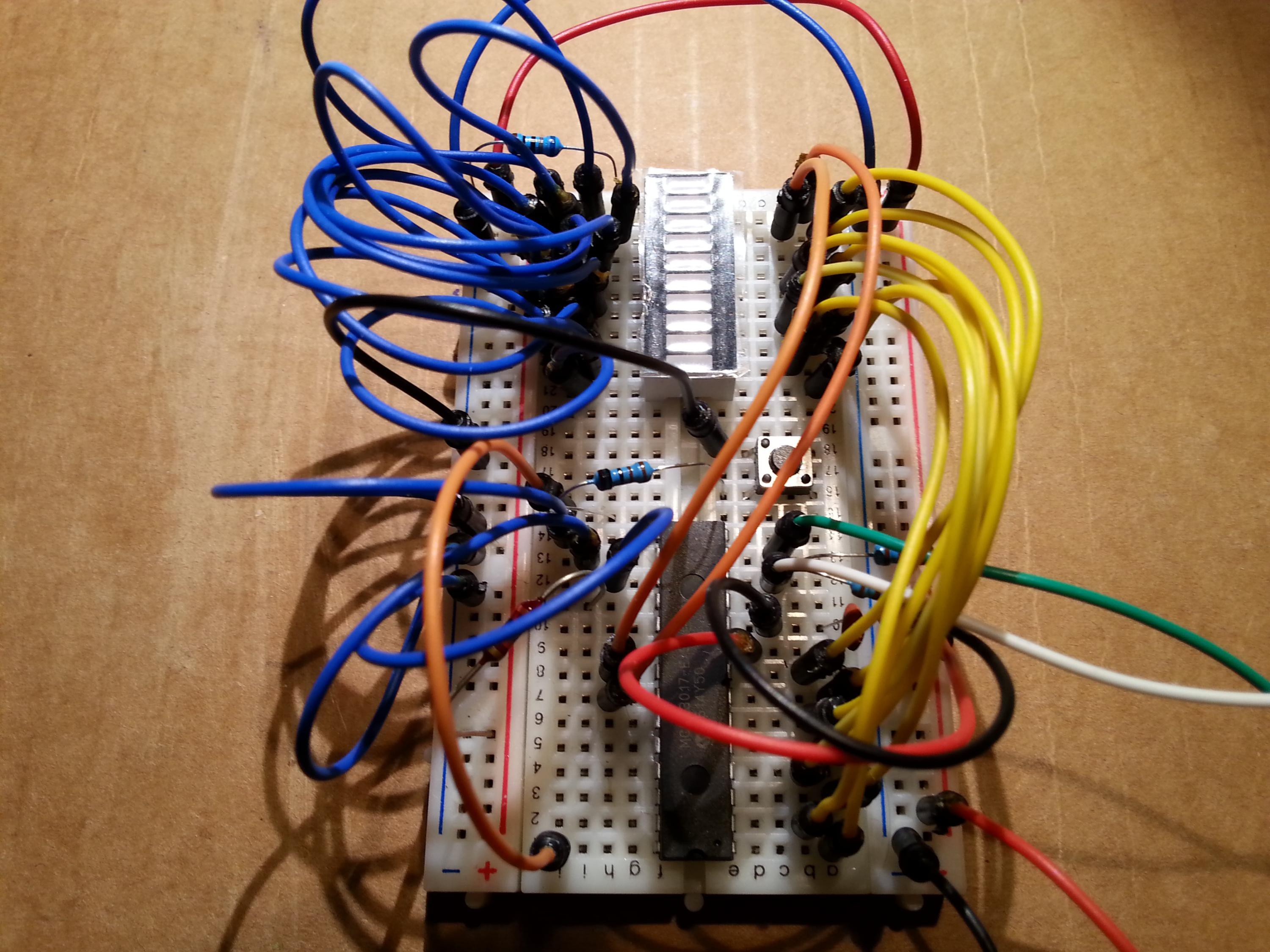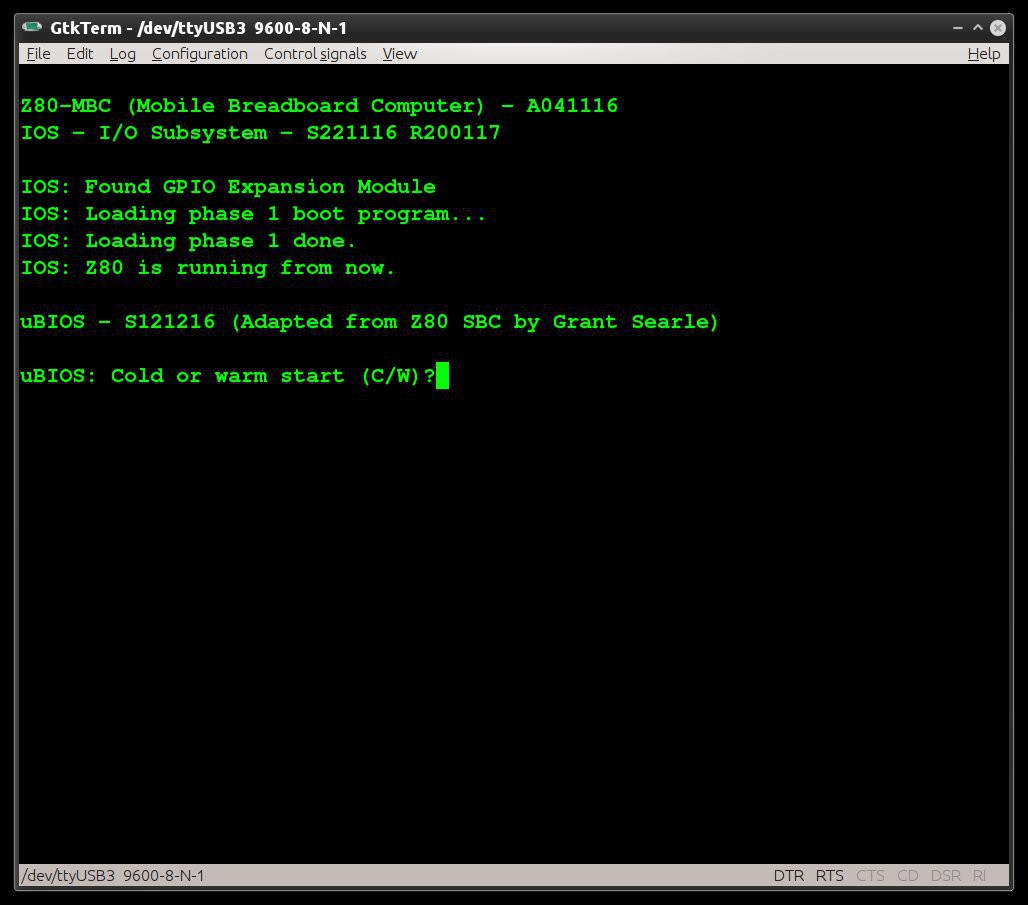This is the first add-on module for the Z80-MBC. It is a 16x GPIOs expansion module based on a MCP23017 IC, and can be easily connected to the Z80-MBC using the IOEXP connector (based on a I2C serial interface), of course on a breadboard...

In the Files section I've added the schematic (A080117.pdf) and all the KiCad4 files (A080117 Kicad4.zip).
There is also a new release of the IOS (S221116_R200117_Z80.ino) that takes care of it. During the boot phase, if the GPIO expansion module is found, a specific text is displayed:

No configuration is needed, just plug it.
Here is a short demo video:
Each GPIO can be configured as input or output, and for each single input it is possible activate a 100K pull-up resistor. Of course this can be done from the Basic language, using new "virtual" I/O addresses as a language extension (if the module is not present, these I/O addresses are simply ignored):
New WRITE I/O addresses:
0x03:
// GPIOA write (GPIO Expansion Module):
// I/O DATA: D7 D6 D5 D4 D3 D2 D1 D0
// ---------------------------------------------------------
// D7 D6 D5 D4 D3 D2 D1 D0 GPIOA value (see MCP32017 datasheet)
0x04:
// GPIOB write (GPIO Expansion Module):
// I/O DATA: D7 D6 D5 D4 D3 D2 D1 D0
// ---------------------------------------------------------
// D7 D6 D5 D4 D3 D2 D1 D0 GPIOB value (see MCP32017 datasheet)
0x05:
// IODIRA write (GPIO Expansion Module):
// I/O DATA: D7 D6 D5 D4 D3 D2 D1 D0
// ---------------------------------------------------------
// D7 D6 D5 D4 D3 D2 D1 D0 IODIRA value (see MCP32017 datasheet)
0x06:
// IODIRB write (GPIO Expansion Module):
// I/O DATA: D7 D6 D5 D4 D3 D2 D1 D0
// ---------------------------------------------------------
// D7 D6 D5 D4 D3 D2 D1 D0 IODIRB value (see MCP32017 datasheet)
0x07:
// GPPUA write (GPIO Expansion Module):
// I/O DATA: D7 D6 D5 D4 D3 D2 D1 D0
// ---------------------------------------------------------
// D7 D6 D5 D4 D3 D2 D1 D0 GPPUA value (see MCP32017 datasheet)
0x08:
// GPPUB write (GPIO Exp. Mod. ):
// I/O DATA: D7 D6 D5 D4 D3 D2 D1 D0
// ---------------------------------------------------------
// D7 D6 D5 D4 D3 D2 D1 D0 GPPUB value (see MCP32017 datasheet)New READ I/O addresses:
0x03:
// GPIOA read (GPIO Expansion Module):
// I/O DATA: D7 D6 D5 D4 D3 D2 D1 D0
// ---------------------------------------------------------
// D7 D6 D5 D4 D3 D2 D1 D0 GPIOA value (see MCP32017 datasheet)
//
// NOTE: a value 0x00 is forced if the GPIO Expansion Module is not present
0x04:
// GPIOB read (GPIO Expansion Module):
// I/O DATA: D7 D6 D5 D4 D3 D2 D1 D0
// ---------------------------------------------------------
// D7 D6 D5 D4 D3 D2 D1 D0 GPIOB value (see MCP32017 datasheet)
//
// NOTE: a value 0x00 is forced if the GPIO Expansion Module is not presentAnd here is the Basic program used in the video (the HW wiring is shown in the comments):
1 REM * * * GPIO EXPANSION MODULE (A080117) DEMO * * *
2 REM
3 REM (USER Key -> slow led, GPIO-A(9) Key -> fast led)
4 REM --------------------------------------------------
5 REM Demo HW wiring (see A080117 schematic):
6 REM
7 REM GPIO-B
8 REM (J3)
9 REM +----+ LED
10 REM | 2 |--->|---+
11 REM | 3 |--->|---+ RESISTOR
12 REM | 4 |--->|---+ 680
13 REM | 5 |--->|---+-------/\/\/-----o GND
14 REM | 6 |--->|---+
15 REM | 7 |--->|---+
16 REM | 8 |--->|---+
17 REM | 9 |--->|---+
18 REM +----+ |
19 REM |
20 REM |
21 REM GPIO-A |
22 REM (J4) |
23 REM +----+ LED |
24 REM | 2 |--->|---+
25 REM | 3 |--->|---+
26 REM | 4 |x
27 REM | 5 |x
28 REM | 6 |x
29 REM | 7 |x PUSH BUTTON RESISTOR
30 REM | 8 |x --- 1K
31 REM | 9 |---------o o------------------/\/\/-----o GND
32 REM +----+
33 REM
34 REM
35 REM
36 REM --------------------------------------------------
37 REM
38 REM Set MCP23017 GPIOB all pins as output (IODIRB=0x00)
39 OUT 6, 0
40 REM Set MCP23017 GPIOA 0-1 as output, others as input (IODIRA=0xFC)
41 OUT 5, 252
42 REM Set MCP23017 GPIOA 2-7 pull-up resistor on (GPPUA=0xFC)
43 OUT 7, 252
45 REM Left Shift user funcion definition
50 DEF FNLSH(X)=((X*2) AND 255)
55 REM Init GPIO output ports
60 OUT 3, 0 : REM Clear MCP23017 GPIOA port
62 OUT 4, 0 : REM Clear MCP23017 GPIOB port
64 GOSUB 700 : REM Set slow shift
68 REM Main
70 A=1
80 FOR I=0 TO 7
90 OUT 4, A : REM Write to MCP23017 GPIOB port
100 GOSUB 500
110 A=FNLSH(A)
120 NEXT I
130 OUT 4, 0 : REM Clear MCP23017 GPIOB port
135 A=1
140 FOR I=0 TO 1
150 OUT 3, A : REM Write to MCP23017 GPIOA port
160 GOSUB 500
170 A=FNLSH(A)
190 NEXT I
200 OUT 3, 0 : REM Clear MCP23017 GPIOA port
210 GOTO 70 : REM Play it again, Sam...
220 REM
500 REM * * * * * DELAY SUB
505 FOR J=0 TO K
507 IF INP(0)=1 THEN GOSUB 700 : REM Read USER key
508 IF (INP(3) AND 128)=0 THEN GOSUB 600 : REM Read MCP23017 GPIOA 7 key
510 NEXT J
520 RETURN
530 REM
600 REM * * * * * SET FAST SHIFT SUB
610 K=1
620 OUT 0, 1 : REM USER led ON
630 RETURN
640 REM
700 REM * * * * * SET SLOW SHIFT SUB
710 K=30
720 OUT 0, 0 : REM USER led OFF
730 RETURN--> Important Note: If you use a terminal emulator to send the file to the Z80-MBC, configure it to add a 40ms delay each "end of line". Because Arduino bootloader "environment" doesn't manage any handshaking on the serial port, this is needed for a correct file transfer.
 Just4Fun
Just4Fun
Discussions
Become a Hackaday.io Member
Create an account to leave a comment. Already have an account? Log In.
Very nice ASCII schematic :)
Are you sure? yes | no
:-)
Are you sure? yes | no